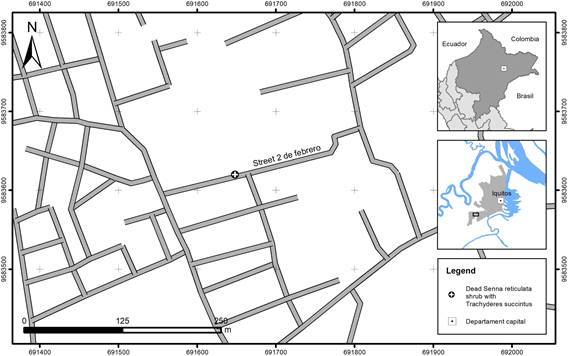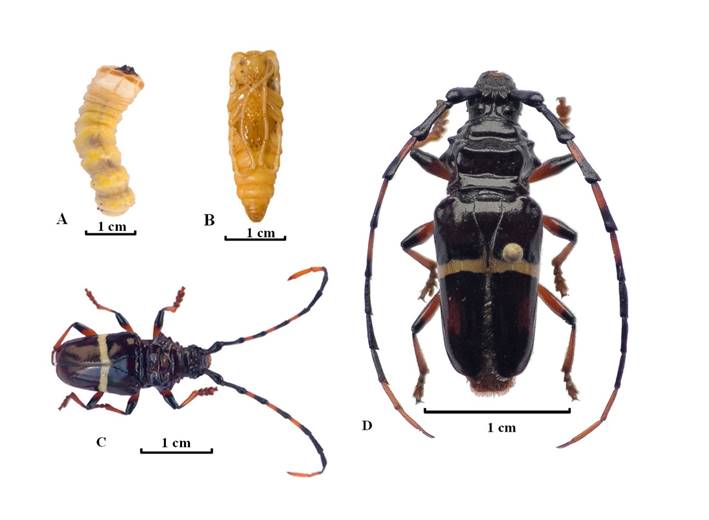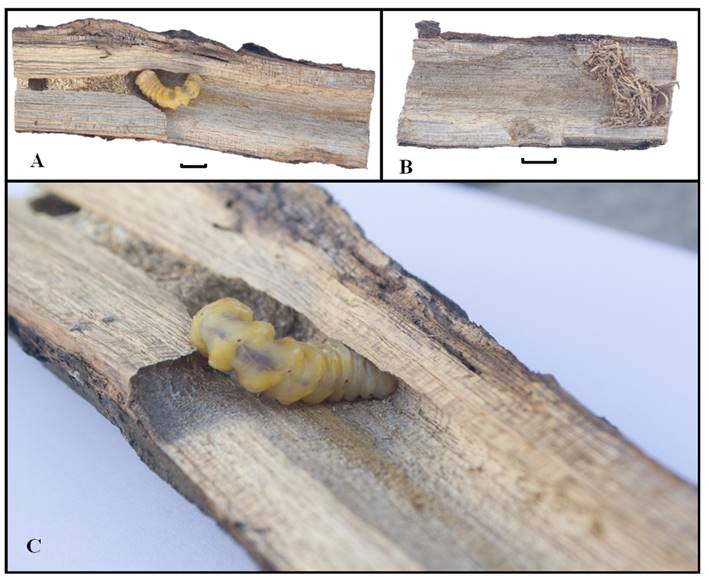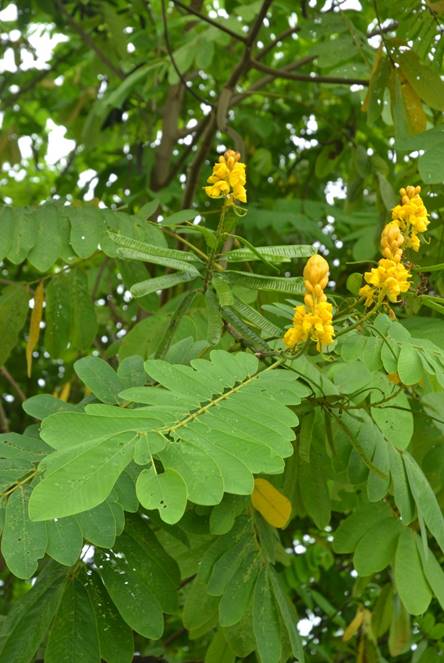According to MINAM (2010), there are estimated to be ~3000 species of beetles (Coleoptera) in Peru. Cerambycidae is represented in the country by 5 subfamilies, 405 genera, and 854 species (Monné & Chaboo, 2015).
Trachyderes succincta succincta is a black or reddish-brown species with a yellow or whitish-yellow transverse band on the elytra (rarely absent) and long antennae characteristic of the Cerambycidae (Barreto et al., 2013; Martins, 1975). It is distributed from Mexico to Argentina (Barreto et al., 2013), while T. succincta succincta is distributed from Nicaragua to Argentina and it is associated with the following host plants: Mangifera indica L., Schinopsis balansae Engl. (Anacardiaceae); Aspidosperma sp. (Apocynaceae), Brassica sp. (Brassicaceae); Hevea brasiliensis (Willd. ex A.Juss.) Müll.Arg., Alchornea bogotensis Pax & K.Hoffm. (Euphorbiaceae); Acacia decurrens (J.C.Wendl.) Willd., Paubrasilia echinata (Lam.) Gagnon, H.C.Lima & G.P.Lewis, Libidibia ferrea (Mart. ex Tul.) L.P.Queiroz, Cassia grandis L.f., Erythrina sp., Hymenolobium flavum Kleinhoonte, Hymenaea courbaril L., Inga ingoides (Rich.) Willd., I. laurina (Sw.) Willd., Mora excelsa Benth., Mimosa scabrella Benth., Mimosa pigra L. (Fabaceae); Persea americana Mill. (Lauraceae); Bertholletia excelsa Bonpl. (Lecythidaceae), Theobroma cacao L. (Malvaceae); Ficus sp., Morus alba L. (Moraceae); Eucalyptus grandis W.Hill ex Maiden, Psidium guajava L. (Myrtaceae); Coffea arabica L. (Rubiaceae); Citrus sp. (Rutaceae); Salta triflora (Griseb.) Adr.Sanchez (Polygonaceae); Sideroxylon rotundifolium (Sw.) T.D.Penn. (Sapotaceae); Handroanthus heptaphyllus (Vell.) Mattos (Bignoniaceae); Lantama camara L. (Verbenaceae); Khaya ivorensis A.Chev. (Meliaceae) (Monné & Chaboo, 2015; Salazar-E, 2013; Fernandes & Santos, 2008; Gonzalez & Di Iorio, 1996; Fujihara et al., 2021; Monné, 2024).
Senna reticulata (Willd.) H.S.Irwin & Barneby belongs to the Fabaceae family, which is often found in alluvial plain areas rich in nutrients (Vásquez, 1997) and in deforested areas (Garate-Quispe et al., 2021). This plant has compound leaves with 8-14 leaflets that are obovate-oblong in shape, obtuse, mucronate, glabrous on both sides, and has rectangular petioles. The flowers are yellow and the fruits are elongated legumes. Trees can reach 4-8 m height with a maximum diameter at breast height (DBH) of 13 cm. Over 50% of its seeds germinate on the fifth day of planting, producing flowers and mature fruits between 9-12 months. Blooming takes place during the flooding season, mature their fruits, and release seeds during the receding phase of the rivers (Parolin 2001, 2016; Trindade et al. 2021). Senna reticulata is widely used for medicinal purposes and serves as a source of bioenergy for rural communities. Additionally, it captures and benefits high amounts of CO2, making it important for climate change mitigation (Rámirez et al. 2013; Saraiva et al. 2018; Grandis et al. 2021). Senna reticulata is associated to other insects species such as Crypticerya genistae Hempel, 1912, C. multicicatrices Kondo and Unruh, 2009 (Hemiptera: Monophlebidae) , Sennius lawrencie Johnson, 1977 and S. lebasi Fähraeus, 1839 (Coleoptera: Chrysomelidae) (Arias de López et al., 2022; Viana, 2011). Further investigation is needed to understand the relationship between these insects and species of Senna Mill.
The study was carried out in a local garden at 2 de Febrero Street, in the Anita Cabrera neighborhood, located in the San Juan Bautista district, Maynas province, Loreto department, 3°45'55.22"S, 73°16'27.34"O, at an altitude of 126 meters above sea level, Peru (Figure 1). The climate of the region is moderately humid and warm, with little to no dry season deficiency, and seasonally homogeneous rainfall concentration, with a precipitation range of 2500 to 2600 mm and a temperature range of 21.3 to 32.8 °C (Paredes, 2012; Tello et al., 2013). The garden where the shrub was located is situated between a sidewalk and a concrete sidewalk road, and the neighborhood has few green areas (Palacios et al., 2020). Sampling was conducted on November 10, 2022, with three larval stage specimens collected from the dead wood of the shrub. The larvae were reared on the dead branches of their host plant, inside plastic containers to prevent external interference. Several photographs were taken to document the process.

Figure 1 Location map of the dead Senna reticulata shrub where Trachyderes succincta succincta was found in Iquitos, Loreto, Perú.
The plant identification was done using the botanical key by Vásquez (1997), bibliographic information from WFO (2023), The Field Museum of Chicago (2023), and speciesLink ( 2023). the species and subspecies of the beetle was identified with the key of Hudepol (1985) and Monné & Wang (2017).
The specimens studied were longicorn beetles of the family Cerambycidae, subfamily Cerambycinae, tribe Trachyderini. They measured 22.18 mm and 22.41 mm, elongated bodies of dark brown and light brown colors (possibly not yet completed its sclerotization process), long antennae that exceed the length of the body, all femurs and the second, third and fourth antennal arrays are bicolored (dark brown and copper), tibiae and the last three antennal arrays are copper colored, presence of a thin yellow transverse band in the middle part of both elytra.
Around September 2022, the host shrub died, possibly after only 4 years of life, and the dry branches and stem became a hazard for pedestrians. Therefore, we decided to cut it down. During the cutting, we discovered the larvae, which marked the beginning of this research project.
The beetle corresponded to Trachyderes succincta succincta (Linnaeus, 1758), from the family Cerambycidae (Figures 2 and 3), and the shrub was identified as Senna reticulata (Figures 3 and 4). This represents the first record of this relationship. Trachyderes succincta succincta larva was found in galleries within the branches of Senna reticulata, and was reared on branches of this species until reaching adulthood. The first adult emerged on December 18, 2022, the second on April 16, 2023, and the third on May 25, 2023 (see Table 1).

Figure 2 Photographs of live Trachyderes succincta succincta reported in Senna reticulata in the present study; A. live larva, B. live pupa, C. live adult, and D. mounted specimen of an adult.
Table 1 Dates and stages of three larvae of Trachyderes succincta succincta in Senna reticulata Wood in Iquitos, Peru.
| Individual | 2022 | 2023 | ||||
| 10-nov | 18-Dec | 31-Dec | 14-Apr | 25-Apr | 25-may | |
| 1 | Larva | Adult | ||||
| 2 | Larva | Pupa | Adult | |||
| 3 | Larva | Larva | Pupa | Adult | ||
Apparently, Trachyderes succincta succincta larvae has a preference for plant species in the order Fabales (11 species), which is consistent with our findings. Based on the Angiosperm Phylogeny Group (2016), the 27 plant species where T. succincta succincta larvae have been reported, predominately belong to the Rosids group, a branch of flowering plants located at the center of plant phylogenetic evolution.












 uBio
uBio 



